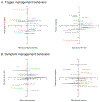Managing children's asthma: what role do caregivers' mental representations of trigger and symptom management behaviors play?
- PMID: 38682920
- PMCID: PMC11518878
- DOI: 10.1080/08870446.2024.2347657
Managing children's asthma: what role do caregivers' mental representations of trigger and symptom management behaviors play?
Abstract
Objective: Pediatric asthma management is challenging for parents and guardians (hereafter caregivers). We examined (1) how caregivers mentally represent trigger and symptom management strategies, and (2) how those mental representations are associated with actual management behavior.
Methods: In an online survey, N = 431 caregivers of children with asthma rated 20 trigger management behaviors and 20 symptom management behaviors across 15 characteristics, and indicated how often they engaged in each behavior.
Results: Principal components analysis indicated 4 dimensions for trigger management behaviors and 3 for symptom management behaviors. Bayesian mixed-effects models indicated that engagement in trigger management behavior was more likely for behaviors rated as affirming caregiver activities. However, trigger management behavior did not depend on how highly the behavior was rated as challenging for caregiver, burdensome on child, or routine caregiving. Engagement in symptom management behavior was more likely for behaviors rated as affirming and common and harmless to the child, but was unrelated to how highly a behavior was rated as challenging for caregivers.
Conclusion: These results suggest that interventions might be particularly useful if they focus on the affirming nature of asthma management behaviors. However, such interventions should acknowledge structural factors (e.g. poverty) that constrain caregivers' ability to act.
Keywords: Asthma; adolescent; behavior; child; parent.
Conflict of interest statement
Declaration of Conflicts of Interest
The Authors declare that there are no conflicts of interest.
Figures


References
-
- Adler NE, Epel ES, Castellazzo G, et al. (2000) Relationship of subjective and objective social status with psychological and physiological functioning: preliminary data in healthy white women. Health Psychology 19(6): 586–592. - PubMed
-
- Asher I and Pearce N (2014) Global burden of asthma among children. International Journal of Tuberculosis and Lung Disease 18(11): 1269–1278. - PubMed
-
- Asthma and Allergy Foundation of America (2020) Asthma Disparities in America: A Roadmap to Reducing Burden on Racial and Ethnic Minorities. Available at: https://www.aafa.org/media/2743/asthma-disparities-in-america-burden-on-... (accessed August 1).
MeSH terms
Grants and funding
LinkOut - more resources
Full Text Sources
Medical
